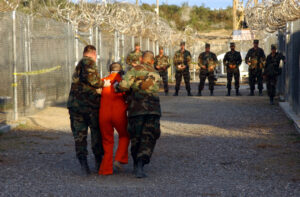The Earth Loses a Force of Nature
TL Caswell, a Truthdig journalist who worked at the LA Times with cartoonist Paul Conrad (above), the three-time Pulitzer winner who died Saturday, remembers a man who always arrived in a blast of smoke and soundA Truthdig journalist who worked with cartoonist Paul Conrad at the L Times remembers a man who always arrived in a blast of smoke and sound.
While working on the Truthdig site Saturday afternoon, I saw a newly posted item headed “Legendary Cartoonist Paul Conrad Dies.” I was surprised, because I didn’t know earthquakes could die.
Let me explain what I mean.
Before I joined Truthdig at its inception five years ago, I had a long and happy career at the Los Angeles Times, where Conrad was the chief editorial cartoonist from 1964 to 1993. One of the pleasant aspects of working on the copy desks back in the 1970s and ’80s was that the editors sometimes were shifted around within the large daily to fill in for vacationing colleagues. One of the departments I would go to on occasion was Editorial Writers. I did not know then that years later I would retire as the copy desk chief there.
While working as a substitute — editing editorials, letters to the editor and Op-Ed articles — I had a sense of being at the pulsing heart of the organization, the spot where the opinions of the Times were born. It was during one of those fill-in stints that I first encountered Paul Conrad.
He impressed me in several ways, and I must confess I was slightly in awe of him. First of all, he had two Pulitzer Prizes at the time, and later he would win still another. Count ’em, three Pulitzers. The dream of most journalists is to win one, and here was a guy who would pull off the hat trick, being declared the best in his specialty in 1964, ’71 and ’84.
Then there was his physical presence. His obituary in Sunday’s L.A. Times mentioned he was 6 feet, 2 inches tall, but in my memory he seemed an inch or two above that. He was a good-looking guy in those days, I thought, and when he arrived in a room there was the sensation that he was being heralded by trumpets. If you happened not to see him, you would always smell him or hear him: He sent out clouds of smoke from the pipe he brandished, and he had a booming voice that he was not shy about using to announce himself. He certainly was not a man who sneaked up on you. Conrad would walk past the various offices, loudly saluting their occupants with a hail-fellow-well-met flair.
Although the cartoonist was unfailingly polite to me, someone he did not know well, he was not one to manicure his words. He was known for speaking his mind in a very direct way that sometimes had edges untouched by social polish.
After his daily arrival, often I would not hear him again for several hours, while he was at work at his drawing board.
When he would leave, he would give me a sketch of the cartoon that was to be published that night so I could ensure the right drawing went to press. These “roughs” were remarkable in terms of quality. I once gave a couple of them to a woman I took to a nearby restaurant; she was impressed with the drawings, less so with me.
To make sure his cartoons were solely the products of his own imagination, Conrad would refuse to hear any suggestions for subjects. After a friend of mine asked me to convey such a suggestion to Conrad, the cartoonist cut me off when I tried to do so.
One of Conrad’s claims to fame was that he was on the notorious “enemies list” of Richard Nixon. The liberal wore the Republican president’s hatred like a badge of honor. I recall that at one time during the Nixon era — and I hope my former Times colleagues will correct me if my memory has failed here — Conrad was threatened by the Secret Service. The story going around was that because he had drawn a cartoon depicting a piece of U.S. currency, the Secret Service was growling about charging him under anti-counterfeiting laws that made it a crime to reproduce the image of American currency. This was patently a ridiculous act of political vindictiveness by the government. There was no way an image in a newspaper cartoon could be an attempt at counterfeiting or could aid someone seeking to create a counterfeit bill.
As far as I know, no investigation ever occurred, and Conrad obviously was not intimidated. In the Conrad cartoon that Truthdig used to illustrate its news brief on the cartoonist’s passing at age 86, Afghanistan’s Karzai is depicted wearing a hat in the form of a carefully detailed “1-million-dollar” bill.
In the L.A. Times obit, one of Conrad’s admirers, in addition to calling him a “force of nature,” said he was a man you measured “on the Richter scale.” Yeah, that matches my memory of him. He was a shaker, both personally and journalistically, and we won’t feel one like him again.
T.L. Caswell was on the Los Angeles Times editing staff for more than 25 years and now edits and writes for Truthdig.
Your support matters…Independent journalism is under threat and overshadowed by heavily funded mainstream media.
You can help level the playing field. Become a member.
Your tax-deductible contribution keeps us digging beneath the headlines to give you thought-provoking, investigative reporting and analysis that unearths what's really happening- without compromise.
Give today to support our courageous, independent journalists.






You need to be a supporter to comment.
There are currently no responses to this article.
Be the first to respond.